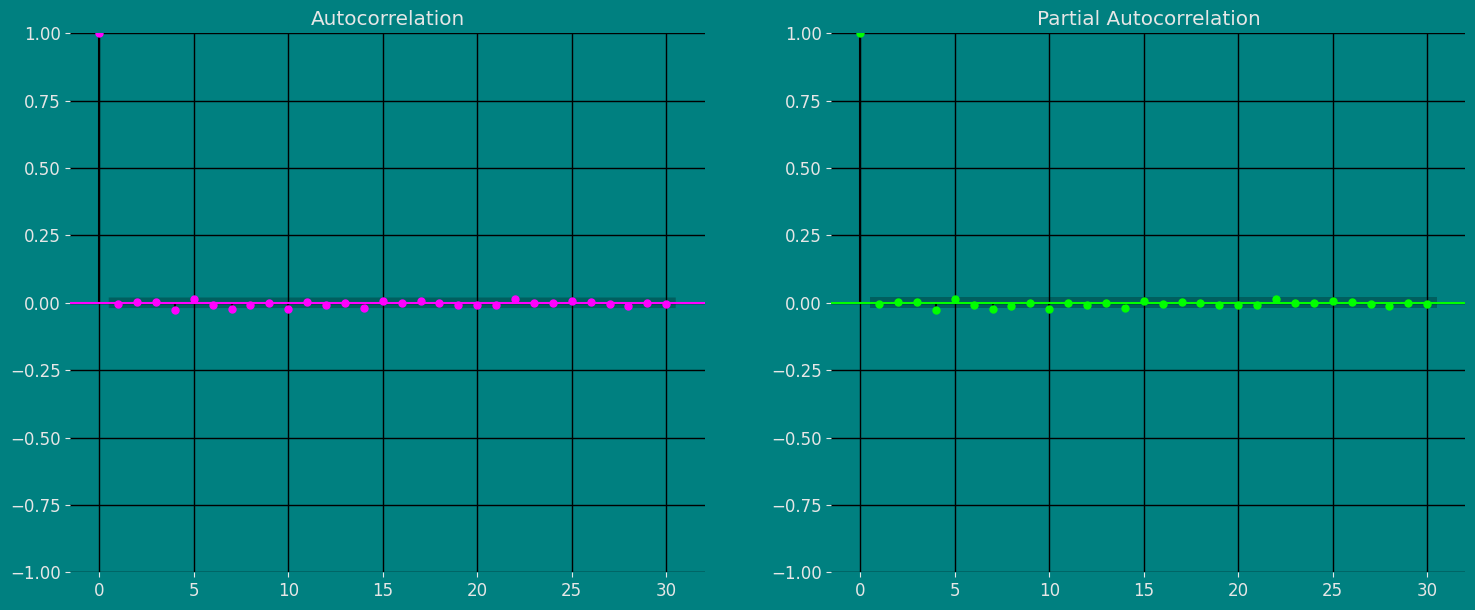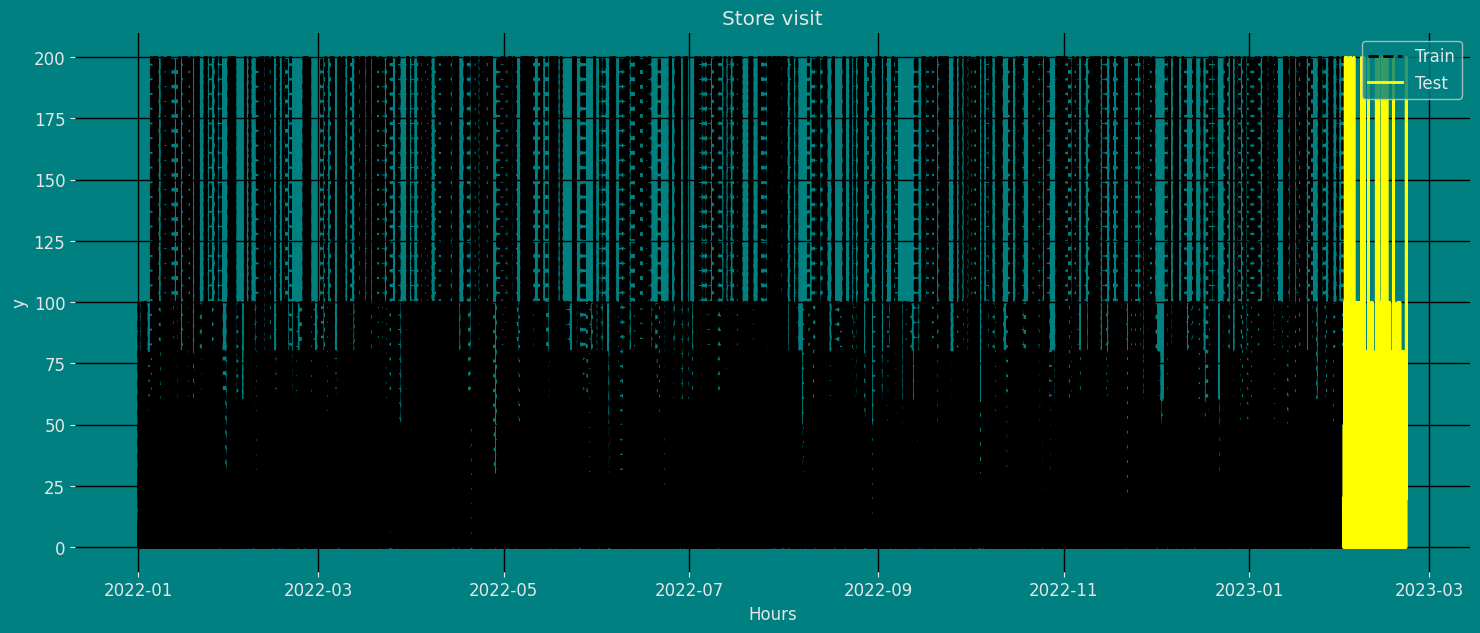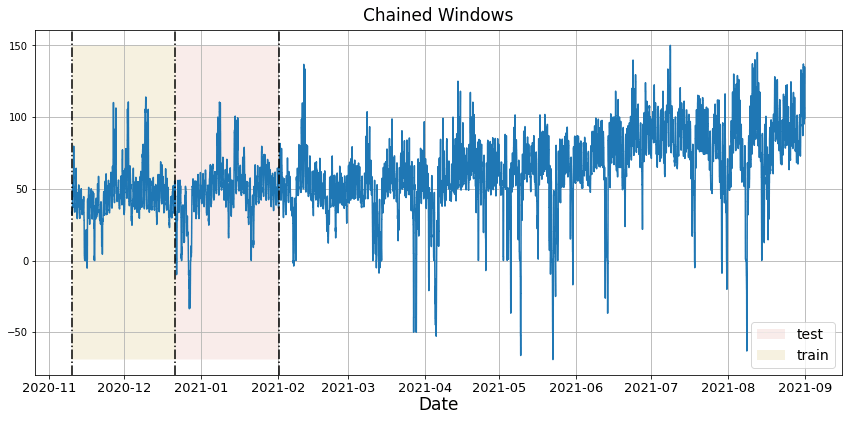Step-by-step guide on using theDuring this walkthrough, we will become familiar with the mainIMAPA ModelwithStatsforecast.
StatsForecast class and some relevant methods such as
StatsForecast.plot, StatsForecast.forecast and
StatsForecast.cross_validation in other.
The text in this article is largely taken from: 1. Changquan Huang •
Alla Petukhina. Springer series (2022). Applied Time Series Analysis and
Forecasting with
Python. 2.
Ivan Svetunkov. Forecasting and Analytics with the Augmented Dynamic
Adaptive Model (ADAM) 3. James D.
Hamilton. Time Series Analysis Princeton University Press, Princeton,
New Jersey, 1st Edition,
1994.
4. Rob J. Hyndman and George Athanasopoulos (2018). “Forecasting
Principles and Practice (3rd ed)”.
Table of Contents
- Introduction
- IMAPA Model
- Loading libraries and data
- Explore data with the plot method
- Split the data into training and testing
- Implementation of IMAPA with StatsForecast
- Cross-validation
- Model evaluation
- References
Introduction
IMAPA is an algorithm that uses multiple models to forecast the future values of an intermittent time series. The algorithm starts by adding the time series values at regular intervals. It then uses a forecast model to forecast the added values. IMAPA is a good choice for intermittent time series because it is robust to missing values and is computationally efficient. IMAPA is also easy to implement. IMAPA has been tested on a variety of intermittent time series and has been shown to be effective in forecasting future values.IMAPA Method
The Intermittent Multiple Aggregation Prediction Algorithm (IMAPA) model is a time series model for forecasting future values for time series that are intermittent. The IMAPA model is based on the idea of aggregating the time series values at regular intervals and then using a forecast model to forecast the aggregated values. The aggregated values can be forecast using any forecast model. It uses the optimized SES to generate the forecasts at the new levels and then combines them using a simple average. The IMAPA model can be defined mathematically as follows: where is the forecast time value , is the forecast model, are the forecasts of the added values at times , and is the time interval over which the time series values are aggregated. IMAPA is a good choice for intermittent time series because it is robust to missing values and is computationally efficient. IMAPA is also easy to implement. IMAPA has been tested on a variety of intermittent time series and has been shown to be effective in forecasting future values.IMAPA General Properties
- Multiple Aggregation: IMAPA uses multiple levels of aggregation to analyze and predict intermittent time series. This involves decomposing the original series into components of different time scales.
- Intermittency: IMAPA focuses on handling intermittent time series, which are those that exhibit irregular and non-stationary patterns with periods of activity and periods of inactivity.
- Adaptive Prediction: IMAPA uses an adaptive approach to adjust prediction models as new data is collected. This allows the algorithm to adapt to changes in the time series behavior over time.
- Robust to Missing Values: IMAPA can handle missing values in the data without sacrificing accuracy. This is important for intermittent time series, which often have missing values.
- Computationally Efficient: IMAPA is computationally efficient, meaning it can forecast future values quickly. This is important for large time series, which can take a long time to forecast using other methods.
- Decomposition Property: Time series can be decomposed into components such as trend, seasonality, and residual components.
Loading libraries and data
Tip Statsforecast will be needed. To install, see instructions.Next, we import plotting libraries and configure the plotting style.
| date | sales | |
|---|---|---|
| 0 | 2022-01-01 00:00:00 | 0 |
| 1 | 2022-01-01 01:00:00 | 10 |
| 2 | 2022-01-01 02:00:00 | 0 |
| 3 | 2022-01-01 03:00:00 | 0 |
| 4 | 2022-01-01 04:00:00 | 100 |
-
The
unique_id(string, int or category) represents an identifier for the series. -
The
ds(datestamp) column should be of a format expected by Pandas, ideally YYYY-MM-DD for a date or YYYY-MM-DD HH:MM:SS for a timestamp. -
The
y(numeric) represents the measurement we wish to forecast.
| ds | y | unique_id | |
|---|---|---|---|
| 0 | 2022-01-01 00:00:00 | 0 | 1 |
| 1 | 2022-01-01 01:00:00 | 10 | 1 |
| 2 | 2022-01-01 02:00:00 | 0 | 1 |
| 3 | 2022-01-01 03:00:00 | 0 | 1 |
| 4 | 2022-01-01 04:00:00 | 100 | 1 |
(ds) is in an object format, we need
to convert to a date format
Explore Data with the plot method
Plot some series using the plot method from the StatsForecast class. This method prints a random series from the dataset and is useful for basic EDA.
Autocorrelation plots
Autocorrelation (ACF) and partial autocorrelation (PACF) plots are statistical tools used to analyze time series. ACF charts show the correlation between the values of a time series and their lagged values, while PACF charts show the correlation between the values of a time series and their lagged values, after the effect of previous lagged values has been removed. ACF and PACF charts can be used to identify the structure of a time series, which can be helpful in choosing a suitable model for the time series. For example, if the ACF chart shows a repeating peak and valley pattern, this indicates that the time series is stationary, meaning that it has the same statistical properties over time. If the PACF chart shows a pattern of rapidly decreasing spikes, this indicates that the time series is invertible, meaning it can be reversed to get a stationary time series. The importance of the ACF and PACF charts is that they can help analysts better understand the structure of a time series. This understanding can be helpful in choosing a suitable model for the time series, which can improve the ability to predict future values of the time series. To analyze ACF and PACF charts:- Look for patterns in charts. Common patterns include repeating peaks and valleys, sawtooth patterns, and plateau patterns.
- Compare ACF and PACF charts. The PACF chart generally has fewer spikes than the ACF chart.
- Consider the length of the time series. ACF and PACF charts for longer time series will have more spikes.
- Use a confidence interval. The ACF and PACF plots also show confidence intervals for the autocorrelation values. If an autocorrelation value is outside the confidence interval, it is likely to be significant.

Decomposition of the time series
How to decompose a time series and why? In time series analysis to forecast new values, it is very important to know past data. More formally, we can say that it is very important to know the patterns that values follow over time. There can be many reasons that cause our forecast values to fall in the wrong direction. Basically, a time series consists of four components. The variation of those components causes the change in the pattern of the time series. These components are:- Level: This is the primary value that averages over time.
- Trend: The trend is the value that causes increasing or decreasing patterns in a time series.
- Seasonality: This is a cyclical event that occurs in a time series for a short time and causes short-term increasing or decreasing patterns in a time series.
- Residual/Noise: These are the random variations in the time series.
Additive time series
If the components of the time series are added to make the time series. Then the time series is called the additive time series. By visualization, we can say that the time series is additive if the increasing or decreasing pattern of the time series is similar throughout the series. The mathematical function of any additive time series can be represented by:Multiplicative time series
If the components of the time series are multiplicative together, then the time series is called a multiplicative time series. For visualization, if the time series is having exponential growth or decline with time, then the time series can be considered as the multiplicative time series. The mathematical function of the multiplicative time series can be represented as.
Split the data into training and testing
Let’s divide our data into sets- Data to train our
IMAPA Model. - Data to test our model

Implementation of IMAPA Method with StatsForecast
Load libraries
Instantiating Model
Import and instantiate the models. Setting the argument is sometimes tricky. This article on Seasonal periods by the master, Rob Hyndmann, can be useful forseason_length.
-
freq:a string indicating the frequency of the data. (See pandas’ available frequencies.) -
n_jobs:n_jobs: int, number of jobs used in the parallel processing, use -1 for all cores. -
fallback_model:a model to be used if a model fails.
Fit the Model
IMAPA Model. We can observe it with the
following instruction:
Forecast Method
If you want to gain speed in productive settings where you have multiple series or models we recommend using theStatsForecast.forecast method
instead of .fit and .predict.
The main difference is that the .forecast doest not store the fitted
values and is highly scalable in distributed environments.
The forecast method takes two arguments: forecasts next h (horizon)
and level.
h (int):represents the forecast h steps into the future. In this case, 500 hours ahead.
| unique_id | ds | IMAPA | |
|---|---|---|---|
| 0 | 1 | 2023-01-31 20:00:00 | 28.579695 |
| 1 | 1 | 2023-01-31 21:00:00 | 28.579695 |
| 2 | 1 | 2023-01-31 22:00:00 | 28.579695 |
| … | … | … | … |
| 497 | 1 | 2023-02-21 13:00:00 | 28.579695 |
| 498 | 1 | 2023-02-21 14:00:00 | 28.579695 |
| 499 | 1 | 2023-02-21 15:00:00 | 28.579695 |

Predict method with confidence interval
To generate forecasts use the predict method. The predict method takes two arguments: forecasts the nexth (for
horizon) and level.
h (int):represents the forecast h steps into the future. In this case, 500 hours ahead.
| unique_id | ds | IMAPA | |
|---|---|---|---|
| 0 | 1 | 2023-01-31 20:00:00 | 28.579695 |
| 1 | 1 | 2023-01-31 21:00:00 | 28.579695 |
| 2 | 1 | 2023-01-31 22:00:00 | 28.579695 |
| … | … | … | … |
| 497 | 1 | 2023-02-21 13:00:00 | 28.579695 |
| 498 | 1 | 2023-02-21 14:00:00 | 28.579695 |
| 499 | 1 | 2023-02-21 15:00:00 | 28.579695 |
Cross-validation
In previous steps, we’ve taken our historical data to predict the future. However, to asses its accuracy we would also like to know how the model would have performed in the past. To assess the accuracy and robustness of your models on your data perform Cross-Validation. With time series data, Cross Validation is done by defining a sliding window across the historical data and predicting the period following it. This form of cross-validation allows us to arrive at a better estimation of our model’s predictive abilities across a wider range of temporal instances while also keeping the data in the training set contiguous as is required by our models. The following graph depicts such a Cross Validation Strategy:
Perform time series cross-validation
Cross-validation of time series models is considered a best practice but most implementations are very slow. The statsforecast library implements cross-validation as a distributed operation, making the process less time-consuming to perform. If you have big datasets you can also perform Cross Validation in a distributed cluster using Ray, Dask or Spark. In this case, we want to evaluate the performance of each model for the last 5 months(n_windows=), forecasting every second months
(step_size=50). Depending on your computer, this step should take
around 1 min.
The cross_validation method from the StatsForecast class takes the
following arguments.
-
df:training data frame -
h (int):represents h steps into the future that are being forecasted. In this case, 500 hours ahead. -
step_size (int):step size between each window. In other words: how often do you want to run the forecasting processes. -
n_windows(int):number of windows used for cross validation. In other words: what number of forecasting processes in the past do you want to evaluate.
unique_id:index. If you dont like working with index just runcrossvalidation_df.resetindex().ds:datestamp or temporal indexcutoff:the last datestamp or temporal index for then_windows.y:true valuemodel:columns with the model’s name and fitted value.
| unique_id | ds | cutoff | y | IMAPA | |
|---|---|---|---|---|---|
| 0 | 1 | 2023-01-23 12:00:00 | 2023-01-23 11:00:00 | 0.0 | 15.134251 |
| 1 | 1 | 2023-01-23 13:00:00 | 2023-01-23 11:00:00 | 0.0 | 15.134251 |
| 2 | 1 | 2023-01-23 14:00:00 | 2023-01-23 11:00:00 | 0.0 | 15.134251 |
| … | … | … | … | … | … |
| 2497 | 1 | 2023-02-21 13:00:00 | 2023-01-31 19:00:00 | 60.0 | 28.579695 |
| 2498 | 1 | 2023-02-21 14:00:00 | 2023-01-31 19:00:00 | 20.0 | 28.579695 |
| 2499 | 1 | 2023-02-21 15:00:00 | 2023-01-31 19:00:00 | 20.0 | 28.579695 |
Model Evaluation
Now we are going to evaluate our model with the results of the predictions, we will use different types of metrics MAE, MAPE, MASE, RMSE, SMAPE to evaluate the accuracy.| unique_id | metric | IMAPA | |
|---|---|---|---|
| 0 | 1 | mae | 34.206428 |
| 1 | 1 | mape | 0.637417 |
| 2 | 1 | mase | 0.816042 |
| 3 | 1 | rmse | 45.345223 |
| 4 | 1 | smape | 0.764973 |
References
- Changquan Huang • Alla Petukhina. Springer series (2022). Applied Time Series Analysis and Forecasting with Python.
- Ivan Svetunkov. Forecasting and Analytics with the Augmented Dynamic Adaptive Model (ADAM)
- James D. Hamilton. Time Series Analysis Princeton University Press, Princeton, New Jersey, 1st Edition, 1994.
- Nixtla IMAPA API
- Pandas available frequencies.
- Rob J. Hyndman and George Athanasopoulos (2018). “Forecasting Principles and Practice (3rd ed)”.
- Seasonal periods- Rob J Hyndman.

